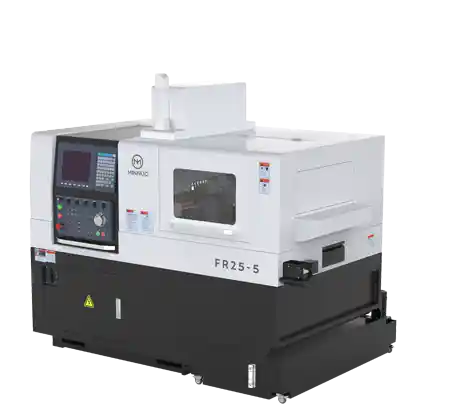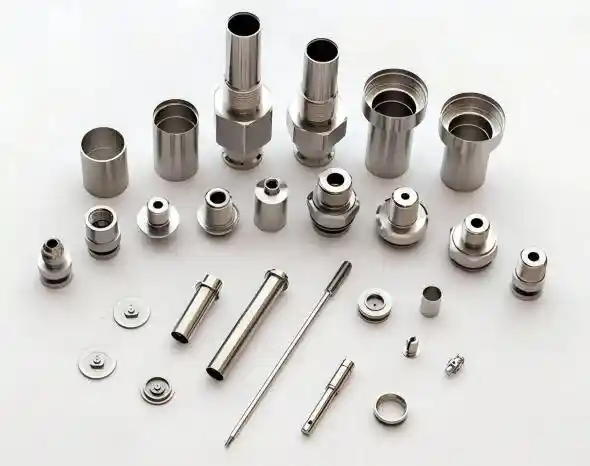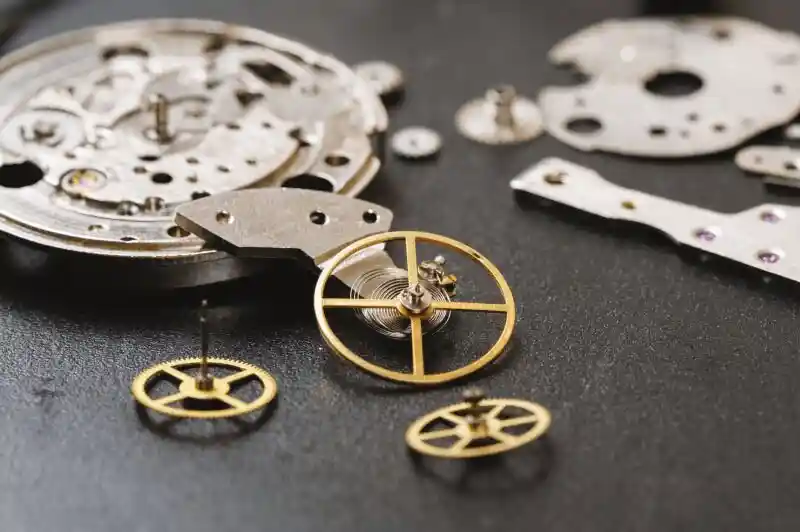What Are the Differences Between Swiss-Type Lathes and Conventional Lathes? Understand the Selection of Precision Part Machining Equipment
In the field of precision part machining, the choice of equipment directly determines product precision, production efficiency, and cost control. As two commonly used types of equipment, Swiss-type lathes and conventional lathes often put purchasers and technicians in a dilemma when making selections. Many enterprises confuse the core differences between the two, leading to incorrect equipment choices that result in low production efficiency, a sharp drop in part qualification rates, and even additional costs for equipment replacement. This article comprehensively analyzes the differences between Swiss-type lathes and conventional lathes from dimensions such as machining principles, structural design, performance parameters, and application scenarios. It also provides a selection guide for precision part machining equipment combined with practical cases to help enterprises accurately match their production needs.
I. Core Concepts: Definitions and Differences in Machining Principles Between Swiss-Type Lathes and Conventional Lathes
To distinguish between Swiss-type lathes and conventional lathes, it is first necessary to clarify their core definitions and machining principles. This serves as the foundation for understanding subsequent differences and the logical starting point for enterprises to select equipment.
(I) Conventional Lathes: The "Fixed Workpiece" Mode of Traditional Cutting
Conventional lathes (also known as traditional lathes or horizontal lathes) are the "basic equipment" in the mechanical machining industry. Their machining principle follows the "fixed workpiece, moving tool" mode. During machining, the workpiece is fixed on the spindle via a 3-jaw or 4-jaw chuck. The spindle drives the workpiece to rotate at high speed, while the tool post drives turning tools (such as external turning tools, internal hole tools, and thread tools) to move linearly or curvilinearly along the guide rails. Through the relative cutting movement between the turning tool and the workpiece, excess material on the workpiece surface is removed, and finally, structures such as cylindrical surfaces, conical surfaces, and threads are formed as required.
The machining process of conventional lathes is relatively simple, making them suitable for single-piece, small-batch production or machining of parts with low precision requirements. For example, when machining a conventional shaft part with a diameter of 50mm and a length of 100mm, a conventional lathe can complete external turning and end face machining in one setup. However, if complex hole systems or special-shaped structures need to be machined, multiple setups and adjustments are required, which easily affects machining efficiency and precision.

(II) Swiss-Type Lathes: The "Fixed Tool, Moving Workpiece" Mode for Precision Machining
Swiss-type lathes, fully known as "Swiss-style CNC lathes" (also called sliding headstock lathes), are high-efficiency machining equipment specially designed for slender shafts and precision complex parts. Their core machining principle is the opposite of that of conventional lathes—the "fixed tool, moving workpiece" mode. The spindle of a Swiss-type lathe adopts a "sliding headstock" design. The workpiece passes through the rear end of the spindle and is continuously fed by a feeding mechanism. While the spindle drives the workpiece to rotate, it moves axially (feed movement). In contrast, the tools fixed on the turret or tool post remain stationary, and cutting machining is achieved through the rotation and axial movement of the workpiece.
In addition, Swiss-type lathes are usually equipped with multi-axis (such as Y-axis, C-axis, and sub-spindle) and multi-tool position structures, enabling them to complete composite machining processes such as turning, milling, drilling, tapping, and grinding simultaneously. For example, when machining a slender precision shaft with a diameter of 8mm and a length of 200mm, a Swiss-type lathe can complete all processes including external turning, radial milling of grooves, axial drilling, and thread machining in one setup without the need for secondary setups, significantly improving precision and efficiency.

II. Key Difference Comparison: A Comprehensive Analysis of the Two Types of Equipment from Structure to Performance
The differences between Swiss-type lathes and conventional lathes not only lie in machining principles but also extend to multiple dimensions such as structural design, machining precision, production efficiency, and application scope. These differences directly determine the application scenarios and cost-effectiveness of the equipment. The following is a detailed comparison from 6 core dimensions:
Comparison Dimension | Conventional Lathes | |
Structural Design | 1. The spindle is fixed in the headstock, and the workpiece is fixed via a chuck, only capable of rotational movement; 2. The tool post usually has 2-4 tool positions, only supporting turning operations without composite functions; 3. No feeding mechanism, requiring manual or simple devices for loading; 4. Guide rails are mostly horizontally arranged, suitable for machining short workpieces. | 1. The spindle can move axially (sliding headstock design), the workpiece passes through the spindle, and is continuously fed by a feeder; 2. Equipped with multi-axis (Y-axis, C-axis, sub-spindle) and multi-turret structures, supporting composite machining such as turning, milling, drilling, and tapping; 3. Equipped with an automatic feeding mechanism, enabling unmanned continuous production; 4. Guide rail layout is adapted to slender workpieces, reducing workpiece vibration. |
Machining Precision | 1. Positioning accuracy: generally 0.01-0.03mm, repeat positioning accuracy 0.005-0.01mm; 2. Multiple setups easily cause clamping errors, and machining of slender workpieces tends to result in "drum-shaped" or "conical" defects; 3. Spindle speed is relatively low (usually ≤3000r/min), limiting cutting stability. | 1. Positioning accuracy: up to 0.001-0.005mm, repeat positioning accuracy 0.0005-0.002mm; 2. All processes are completed in one setup, eliminating clamping errors, and achieving higher precision in machining slender workpieces (roundness ≤0.002mm); 3. Spindle speed is high (usually ≥6000r/min, some models can reach 15000r/min), ensuring more stable cutting. |
Production Efficiency | 1. Single-process machining requires manual clamping, tool change, and inspection, resulting in long intervals between processes; 2. Machining slender workpieces requires frequent adjustment of supports, leading to low efficiency; 3. Efficiency is acceptable for small-batch production (≤100 pieces), but bottlenecks easily occur in mass production. | 1. Composite machining allows all processes to be completed in one setup, with zero interval between processes; 2. Automatic feeding + continuous machining enables 24-hour unmanned production, and the efficiency of mass production (≥1000 pieces) is 3-5 times that of conventional lathes; 3. Simultaneous machining with multiple tools (e.g., external turning by the main spindle + internal hole drilling by the sub-spindle) further improves efficiency. |
Applicable Parts | 1. Short and thick parts: shaft and disk parts with length ≤5 times the diameter (e.g., flanges, bearing sleeves); 2. Simple-structure parts: parts requiring only external turning, end face machining, and simple thread machining; 3. Low-precision parts: general parts with a tolerance range ≥0.01mm. | 1. Slender parts: slender shafts with length ≥10 times the diameter (e.g., medical catheters, electronic pins, clock shafts); 2. Complex precision parts: parts requiring composite machining of turning, milling, and drilling (e.g., automotive sensor shafts, aerospace precision joints); 3. High-precision parts: precision parts with a tolerance range ≤0.005mm (e.g., chip pins, optical instrument parts). |
Cost Investment | 1. Low equipment purchase cost: the price of conventional CNC lathes is approximately 50,000-150,000 yuan, and that of traditional manual lathes is even lower (20,000-50,000 yuan); 2. Low maintenance cost: simple structure, easy maintenance, and low price of spare parts; 3. High labor cost: requiring dedicated operators, and additional labor is needed for mass production. | 1. High equipment purchase cost: the price of entry-level Swiss-type lathes is approximately 200,000-500,000 yuan, and that of high-precision multi-axis Swiss-type lathes can reach 1,000,000-3,000,000 yuan; 2. High maintenance cost: complex structure, requiring professional personnel for maintenance, and high price of spare parts (e.g., precision spindles, feeding mechanisms); 3. Low labor cost: automatic continuous production allows one person to operate multiple pieces of equipment. |
Operation Threshold | 1. Simple operation: low programming difficulty, suitable for beginners to learn, and proficiency can be achieved in 1-2 months; 2. Low skill requirements for operators: no need to master composite machining programming, only basic turning knowledge is required. | 1. Complex operation: requiring mastery of multi-axis linkage programming and composite machining processes, with high programming difficulty; 2. High skill requirements for operators: requiring precision machining experience, and proficiency can be achieved in 3-6 months. Senior technicians also command higher salaries. |
III. How Should Enterprises Choose? 3 Core Scenarios for Accurate Demand Matching
After understanding the differences between Swiss-type lathes and conventional lathes, how should enterprises select equipment based on their own production needs? The following provides practical selection solutions from 3 core scenarios, combined with cost and efficiency formulas.
(I) Scenario 1: Small-Batch, Simple Part Machining — Prioritize Conventional Lathes
If an enterprise’s production needs are "single-piece/small-batch (≤500 pieces), short and thick simple parts (e.g., conventional shaft sleeves, flanges), and low precision requirements (tolerance ≥0.01mm)", choosing a conventional lathe is more cost-effective.
Case Reference: A hardware factory undertakes an order for machining 100 bearing sleeves, with part parameters of "diameter 60mm, length 80mm, external tolerance 0.02mm", requiring only external turning and end face machining. If a conventional CNC lathe is selected, the equipment purchase cost is 120,000 yuan, the labor cost is 5,000 yuan/month (one person operating), and the machining cycle is 3 days. If a Swiss-type lathe is selected, the equipment purchase cost is 300,000 yuan, the labor cost is 3,000 yuan/month (one person operating 2 machines), but the machining cycle is only 1 day. From a cost perspective, the single-batch cost (equipment depreciation + labor + materials) of the conventional lathe is approximately 8,000 yuan, while that of the Swiss-type lathe is approximately 12,000 yuan, making the conventional lathe more economical.
Selection Logic: In small-batch production, the "high efficiency" advantage of Swiss-type lathes cannot be realized; instead, the high equipment cost increases the unit cost. Although conventional lathes have lower efficiency, their low cost input makes them more suitable for small-batch needs.

(II) Scenario 2: Mass Production of Precision Complex Parts — Must Choose Swiss-Type Lathes
If an enterprise’s production needs are "mass production (≥1000 pieces), slender precision parts (e.g., medical catheters, electronic pins), complex composite machining (requiring integrated turning, milling, and drilling), and high precision requirements (tolerance ≤0.005mm)", Swiss-type lathes are the only option.
Case Reference: A medical equipment factory produces disposable infusion catheter connectors, with part parameters of "diameter 5mm, length 150mm, requiring external turning + flat milling + side hole drilling + tapping, tolerance 0.003mm", and an order quantity of 5,000 pieces. If conventional lathes are selected, 4 processes (external turning → flat milling → drilling → tapping) are required, along with 4 machines and 4 workers. The machining cycle is 15 days, and the qualification rate is approximately 85% (errors caused by multiple setups). If a Swiss-type lathe is selected, 1 machine and 1 worker are needed, and all processes are completed in one setup. The machining cycle is 3 days, and the qualification rate is 99.5%. From the perspective of comprehensive cost, the total cost (equipment depreciation + labor + waste loss) of conventional lathes is approximately 60,000 yuan, while that of the Swiss-type lathe is approximately 35,000 yuan. Moreover, the Swiss-type lathe can quickly respond to subsequent orders and improve delivery efficiency.
Selection Logic: In the mass production of precision parts, the "one-setup + composite machining" of Swiss-type lathes can eliminate clamping errors and improve the qualification rate. At the same time, automatic continuous production reduces labor costs, and the high equipment investment can be amortized through mass production, resulting in higher long-term cost-effectiveness.

(III) Scenario 3: Multi-Variety, Medium-Batch Part Machining — Flexibly Choose "Hybrid Configuration"
If an enterprise’s production needs are "multi-variety (5-10 varieties per month), medium-batch (500-1000 pieces per variety), including both simple parts and precision parts", selecting only one type of equipment may easily lead to resource waste. It is recommended to adopt a "conventional lathe + Swiss-type lathe" hybrid configuration.
Configuration Principles:
- Conventional lathes are responsible for: short and thick simple parts, low-precision parts, and small-batch trial-production parts;
- Swiss-type lathes are responsible for: slender precision parts, complex composite machining parts, and parts for stable mass production.
Case Reference: An auto parts factory produces two types of parts. One type is a conventional bearing shaft with "diameter 30mm, length 50mm" (tolerance 0.01mm, batch size 800 pieces/month), and the other is a precision sensor shaft with "diameter 6mm, length 120mm" (tolerance 0.004mm, batch size 600 pieces/month). After adopting the configuration of "1 conventional CNC lathe + 1 entry-level Swiss-type lathe", the conventional lathe processes the bearing shafts with a monthly cost of approximately 12,000 yuan. The Swiss-type lathe processes the sensor shafts with a monthly cost of approximately 15,000 yuan. The total cost is 15% lower than using only Swiss-type lathes (approximately 30,000 yuan/month) and 46% lower than using only conventional lathes (with a qualification rate of less than 70% and a cost of approximately 28,000 yuan/month).
IV. Avoid Common Misunderstandings: Prevent Wrong Selections
In the process of equipment selection, many enterprises fall into cognitive misunderstandings, resulting in mismatches between equipment and needs. Common misunderstandings should be avoided with emphasis:
Misunderstanding: "The Higher the Precision, the Better; Blindly Choose Swiss-Type Lathes"
Some enterprises believe that "equipment with higher precision is more versatile" and choose Swiss-type lathes even when machining low-precision parts, leading to wasted equipment performance. For example, when machining conventional shaft parts with a tolerance of 0.02mm, conventional lathes can fully meet the requirements. If a Swiss-type lathe is selected, the equipment purchase cost increases by 2-3 times, and there is no significant improvement in machining efficiency (the high-speed advantage of Swiss-type lathes cannot be realized in low-precision machining), which instead increases production costs.
Avoidance Suggestion: Select equipment based on the part tolerance requirements. Prioritize conventional lathes for tolerances ≥0.01mm, and choose Swiss-type lathes only when the tolerance is ≤0.005mm.
Do you need me to organize an English comparison table of key parameters for Swiss-type lathes and conventional lathes based on the translated content? This table will extract the core data from the comparison dimension part to make it easier for you to quickly view and compare the parameter differences between the two types of equipment.




 Email
Email sales1: +86 13295238763
sales1: +86 13295238763

